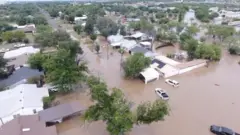Texas Flood Tragedy: Questions Arise Over Early Warning Systems Following Devastating Deluge
Texas Flood Tragedy: Were Early Warnings Adequate?
Devastating flash floods have tragically claimed the lives of nearly 80 individuals in central Texas, with rescue operations still underway and officials cautioning that the death toll is likely to rise. The catastrophic event has spurred critical questions regarding the efficacy and timeliness of flood warnings issued to the affected areas, particularly in Kerr County, where the majority of fatalities, including 28 children, occurred after a girls’ camp was submerged by the rapidly rising waters.
Kerr County Judge Rob Kelly stated that the scale of the flooding was entirely unexpected, asserting, “We had no reason to believe that this was gonna be any, anything like what’s happened here. None whatsoever.” This sentiment underscores the perplexing nature of the disaster, where the rapid escalation of floodwaters seemingly outpaced preparedness measures.

Timeline of Warnings and Response
The flash floods, which began Thursday night and continued into Friday morning, were characterized by an astonishing rate of rainfall, with meteorological data indicating that several months’ worth of rain fell in a matter of hours. The Guadalupe River, a focal point of the devastation, experienced a dramatic rise of 26 feet (8 meters) within a 45-minute period, breaching its banks and unleashing its destructive power.
The sequence of official actions leading up to the disaster is as follows:
- On Wednesday, the Texas Division of Emergency Management (TDEM) proactively activated state emergency response resources in anticipation of increased flooding threats in West and Central Texas.
- On Thursday afternoon, the National Weather Service (NWS) issued a crucial Flood Watch, specifically identifying Kerr County as an area at high risk for overnight flash flooding.
- At 01:14 local time (06:14 GMT) on Friday, a Flash Flood Warning was officially issued for Kerr County.
- Subsequently, at 04:03 local time (09:30 GMT), an emergency flash flood warning was announced for Kerr County, followed by another alert for the Guadalupe River at 05:34.
Examining Preparedness and Communication Failures
In the aftermath, Texas Governor Greg Abbott remarked that Texans are accustomed to flash flood warnings, but the magnitude of this event, described as a “water wall of almost 30ft high,” was unprecedented. Nim Kidd, chief of the Texas Division of Emergency Management, highlighted the challenges posed by areas with limited or no cellular coverage, noting that even robust alert systems could be rendered ineffective in such circumstances.
Concerns have also been raised about public perception of weather warnings. Kerrville City Manager Dalton Rice suggested, as reported by the Associated Press, that the public can become desensitized to frequent warnings. Rice recounted his personal experience, noting that at 03:30 on Friday, the rain was light during his jogging, but by 05:20, the river had risen so rapidly that escape from the park became a challenge.
Judge Kelly further elaborated on the lack of a county-administered warning system, citing prohibitive costs. He revealed that a proposal for a flood warning system, akin to a tornado siren, was considered about six years prior but was never implemented due to financial constraints. This raises significant questions about the prioritization of public safety infrastructure in flood-prone regions.
The NWS, while expressing deep sorrow for the loss of life, defended its actions. The agency stated that its Austin/San Antonio office provided forecast briefings on July 3 and issued a Flood Watch in the early afternoon. Crucially, Flash Flood Warnings were issued on the night of July 3 and the early morning of July 4, providing “preliminary lead times of more than three hours before warning criteria were met.” Following assertions from some Texas officials that the NWS underestimated rainfall, former NWS officials suggested to The New York Times that the forecasts were as accurate as possible given the immense rainfall and the storm’s rapid intensification.
Impact of Staffing and Budget Cuts on Weather Services
The tragedy has also brought to light concerns regarding potential impacts of budget cuts on the National Weather Service (NWS) and its parent agency, the National Oceanic and Atmospheric Administration (NOAA). Reports indicate that the Fiscal Year 2026 budget proposed cuts and closures for certain weather research laboratories, alongside significant staff reductions at NOAA and NWS attributed to the Department of Government Efficiency (Doge).
Meteorologists have voiced concerns that a reduction in the number of weather balloons used for atmospheric observation could affect forecasting accuracy. These balloons are critical for gathering data on wind, humidity, and pressure. Reports suggest a potential 20% decrease in their deployment.
Furthermore, The New York Times reported on vacant critical positions within the NWS on the morning of the disaster, prompting questions about whether staffing shortages hindered the agency’s coordination with local emergency management. However, Tom Fahy, legislative director of the NWS Employees Organization, asserted that weather forecasting offices (WFOs) were adequately staffed and resourced to issue timely forecasts and warnings. Adding to this, Jason Runyen, a meteorologist with the NWS office responsible for the affected region, stated that their office had more staff on duty during the storms than usual, with five personnel present instead of the typical two.
Government Response and Future Preparedness
When questioned about whether the tragedy stemmed from a “fundamental failure” in government-provided early warnings, US Homeland Security Secretary Kristi Noem acknowledged the inherent difficulty in predicting weather patterns but emphasized President Donald Trump’s commitment to modernizing the existing system. Responding to concerns about the impact of NWS budget cuts, Noem pledged to relay these concerns to the federal government, noting that while the NWS has performed commendably over the years, there is a universal desire for enhanced warning times, which necessitates upgrading long-neglected technologies.
Secretary Noem reiterated the challenges in predicting rainfall amounts precisely but assured that the Trump administration would prioritize upgrading warning technologies. She highlighted President Trump’s initiative to fix and upgrade technology since taking office, characterizing the ongoing reforms as essential. President Trump is reportedly planning a visit to the affected area.



Post Comment